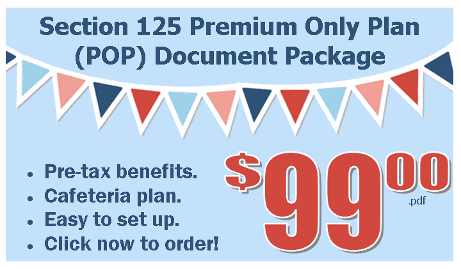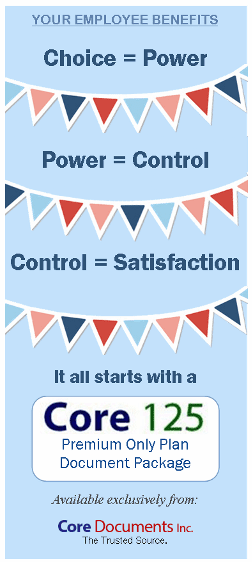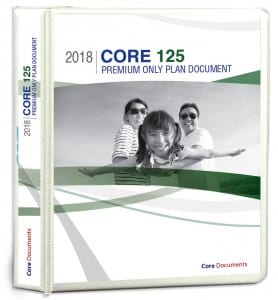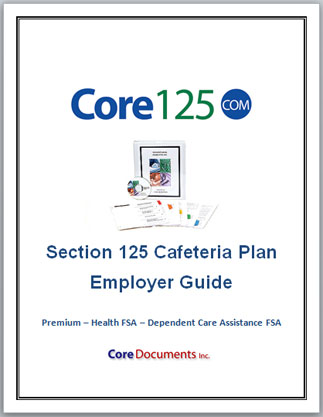Home / Blog / How to meet rising out-of-pocket costs with strategic employer benefit solutions
How to meet rising out-of-pocket costs with strategic employer benefit solutions

Section 125 Plans offer employers most flexibility and savings
One thing we know for sure about the upcoming open enrollment period is that premiums for the same coverage we had last year will be higher. Many employers are wondering how to meet rising out-of-pocket costs with higher deductibles and co-pays to keep health insurance premiums in line, and that’s a smart move. However, to keep that from having a heavy impact on employee household budgets, companies need a strategy that multiplies employee choice in a pre-tax benefit plan.
A survey by Securian Finanial Group, conducted in June 2017, found that 40% of participants in employer-sponsored health benefit plans were having trouble paying medical bills. That’s people with health insurance. Yet, they struggle to pay for the health care they and their families need.
The reason for this is rising out-of-pocket costs. That’s the amount employees are left to pay with their own funds for medical treatments their employer-sponsored group health plan does not cover.
Factors of Rising Out-of-Pocket Costs
Out-of-pocket costs include, at a minimum, covering the plan deductible. As more employers turn to high-deductible health plans (HDHP), employees with individual coverage face a minimum $1,300 annual deductible while families encounter a minimum $2,600 annual deductible for 2017, with these amounts rising slightly for 2018.
 On the upward end of that, the annual limit for rising out-of-pocket costs in 2017 is $6,550 for individuals and $13,100 for families. The out-of-pocket amount is that left to the employee to pay, including, “deductibles, co-payments, and other amounts but not premiums,” according to the Internal Revenue Service (IRS).
On the upward end of that, the annual limit for rising out-of-pocket costs in 2017 is $6,550 for individuals and $13,100 for families. The out-of-pocket amount is that left to the employee to pay, including, “deductibles, co-payments, and other amounts but not premiums,” according to the Internal Revenue Service (IRS).
The reason for the large variance between minimum allowable deductibles for an HDHP and the maximum annual out-of-pocket limit is co-payments. Your plan may have the minimum $2,600 family deductible, but the policy may have an 80-20 coinsurance that kicks in after that deductible.
What that means is, treatment for an unexpected but fairly common ailment like appendicitis or heart failure – around $40,000 – will cost a family $10,080 out-of-pocket. It breaks down to covering the $2,600 deductible plus 20% of the remaining $37,400.
That’s where we find the 40% of participants in employer-sponsored group health plans having trouble paying their medical bills, and employers looking to how to meet rising out-of-pocket costs.

Employer Losses
This situation not only leaves the employee with stress from financial worries but it may impact the employer’s bottom line. Stress can reduce productivity when an employee’s mind wanders toward the issue causing it. Stress also brings a myriad of physical symptoms such as insomnia, headaches, heart disease, even premature death. In short, stress prevents a person from being all that they can be on the job and beyond.
Far worse, looking to escape the health care cost burden, an excellent, top-of-the-line employee may start looking for a position in a company with a more comprehensive benefit package. Not only does an employer risk losing a key member of the team, but there are costs involved in recruiting, hiring, and training a new employee.
The Choice Strategy
How can a small employer design a benefit package that helps employees meet the rising out-of-pocket costs that are inherent in the more affordable HDHP? By offering participants in the plan more choices alongside it while pre-taxing all employee contributions.
An employer does all of this quite affordably with a Section 125 Premium Only Plan (POP).
Pre-Tax Employee Premiums
Section 125 of the Internal Revenue Code allows employers to pre-tax employee premiums by setting up a Section 125 Premium Only Plan Document. This first step will immediately start to save your employees money. By pre-taxing their portion of premiums, an average 20% — and up to twice that, depending on the employee’s tax bracket and other factors — is put back into an employee’s paycheck each period. The employer also saves about 8% in federal payroll taxes on the premiums paid by employees since those dollars are deducted before any tax is calculated on income.
Expand Employee Choices
For employers looking to how to meet rising out-of-pocket costs for employees, the best way is often through:
Premium Only Plan just $99 allows employees to pretax their portion of group health insurance premium plus all forms of supplemental benefits such as life insurance, accident insurance, hospital indemnity coverage, condition-specific policies (Cancer insurance, et al.), and more.
HSA Savings Account Module just $30: This option is growing fastest in popularity, add the Health Savings Account (HSA) savings option to the $99 Premium Only Plan. The HSA module allows employees to pretax their HSA savings at work. This allows the employee and the employer to save an extra 8% in FICA tax (7.65%) and employer matching FICA (another 7.65%) over claiming the HSA savings as a year end tax deduction on the employee 1040 form.
Health FSA Plan just $99 (discounted from $129) when added to a Section 125 Premium Only Plan. This option allows employees to use up to $2,650 annually for out-of-pocket medical, dental, vision and chiropractic expenses. $2,650 in a tax-free Health FSA will save the employee $1,060 in payroll taxes; and the employer saves $199 in matching FICA taxes on each employee.
Dependent Care FSA just $99 (discounted from $129) allows employees to pay for up to $5,000 annually for daycare expenses for a child or adult. The employee saves up to $2,000 annually in payroll taxes; and the employer save $382 in matching FICA taxes.
For the employer, any of these FSA account or HSA modules are easily added to a Section 125 POP document package.
Now you can see why the Section 125 POP is also known as the Cafeteria plan – it puts all of the choices in front of the employee, who selects only what is needed for their specific circumstance.
Get Started Today
 Establishing a Section 125 POP is as simple as having a Plan Document in place and distributing copies of the Summary Plan Description (SPD) to every employee eligible to participate in the group plan.
Establishing a Section 125 POP is as simple as having a Plan Document in place and distributing copies of the Summary Plan Description (SPD) to every employee eligible to participate in the group plan.
For only $99, our Core125 package provides everything you need to set up your Section 125 POP to pre-tax employee-paid health insurance premiums in a group health plan with lots of employee options.
It’s so easy:
- Order your Core125 package;
- Download and print the .pdf Plan Document (arrives via email, usually the same business day);
- Review the document for accuracy, and sign where indicated;
- Make copies of the SPD, giving one to every eligible employee; and then,
- File the Plan Document package with your other payroll or personnel documents.
The Plan Document is not filed with any agency. You just need to keep it on hand, quickly available in case of a new hire or a request by an employee, accountant, or agency.
No special fund or separate account is needed. Simply keep the employee amounts accounted for accordingly in your financial records.
You can get started today by clicking this button:
Order Online
Our secure online ordering system accepts:

If you prefer to order by fax, click here.
*As said earlier, most Core125 POP document packages go out within one business day; however, keep in mind that December, January, and February are our busiest months of the year. Plan documents are processed in the order they are received. The Rush Order fee ($25, available on our order form) simply brings your document to the top of the stack to be processed immediately.
Our friendly and knowledgeable staff are available to
answer any questions you may have via e-mail or phone call,
Monday through Friday, 9 am to 5 pm ET:
1-888-755-3373
[email protected]
Related posts:
Health Savings Account in Section 125 Plans with High Deductible Health Plans
FSA, HSA, and HRA: What’s the difference?
$99 Section 125 plan documents increase take-home pay, employer bonus
Why should an Employer provide HSA Administration to their Employees through CoreAdmin?
Download the Core Documents Section 125 Cafeteria Plan Employer Guide HERE
